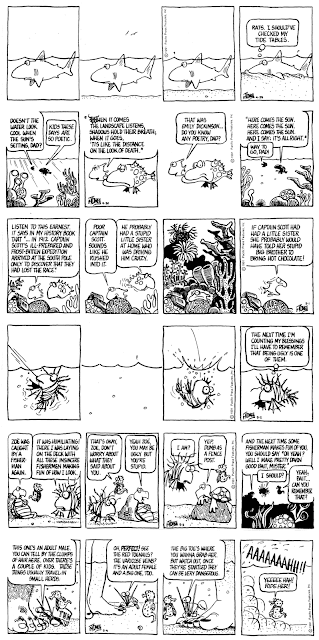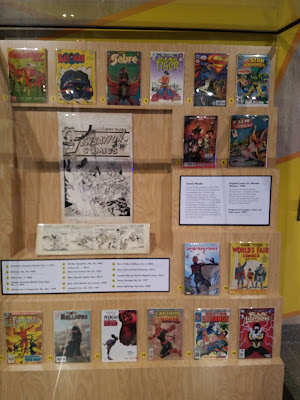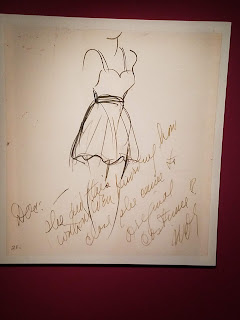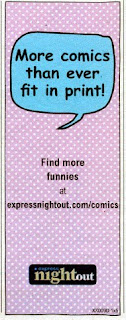 |
| Jim Toomey at American University |
by Mike Rhode
Jim Toomey was in Washington recently to speak to the students of
American University’s Center for Environmental Filmmaking. Toomey is the cartoonist behind
Sherman’s Lagoon, a fanciful look at sharks and undersea life which appears locally in the Washington Post. He’s also done animated cartoon shorts on ocean conservation. His evening talk was open to the public, and afterwards Jim agreed to do an interview. We spoke by telephone a few days later on September 29th.
MR: How long have you been drawing Sherman’s Lagoon?
JT: Over twenty-five years. Well, let’s see… 1991. So twenty-six years now.
MR: How did you come up with the idea?
JT: I had always loved the ocean and was a big fan of Jacques Cousteau. I got my diver’s license by lying about my age to get my scuba certificate when I was eleven. I was a real fanatic about the ocean and all things ocean-related. I was also a big fan of comic strips. I was a paperboy, so I got into the newspaper business pretty young. I particularly liked the strip “Peanuts.” I read other strips as well, but “Peanuts” was really my favorite. I loved to draw, but I didn’t have the discipline to become a very practiced artist. I didn’t do figure sketching or still lives. I didn’t have that kind of discipline. I loved a combination of things: I enjoy telling stories and making people laugh, I love the ocean, and I love to draw in a loose not-so-serious way. Some of those things pointed towards being a cartoonist. The theme of the ocean came along mostly because I was looking for something different. I wanted to get syndicated and I looked in the comics pages and saw a lot of the same thing over and over again. I wanted to try to create something that was totally different. And that’s why I came up with the undersea stuff. My lead character Sherman is a character I’ve had in mind my whole life. I’ve always been fascinated with sharks. I’ve always been drawing sharks.
MR: You were born in Alexandria, VA. Did you grow up there as well?
JT: Yes, I was there until I went away to college at eighteen.
MR: So were you boating on the Potomac River as a kid, or visit the Atlantic shore?

JT: I didn’t do a lot of boating on the Potomac. My family was not a boat family. We did go to the beach quite a bit, off to Rehoboth Beach. I think one of the formative moments of my life was being at Rehoboth, or Dewey, or wherever it was, and seeing the lifeguards shooting at sharks. They had sharks out there and they actually got out a high-power rifle. I remember the image of them shooting at sharks vividly. I was a little shocked by that, I guess; what good would it do? I also saw a fisherman land a good-sized shark – not a dogfish, it was probably four feet long laying on the pier there. I got to look at it and touch it and I was just amazed.
MR: You’re living in Annapolis, MD now, so still not on the ocean?
JT: [laughs] No, but it’s on the water… we spent the last two years on a sailboat on the ocean so I’ve definitely gotten my fill of the ocean. I think the allure of the ocean as a boy was the same drivers that come with being fascinated by outer space, or dinosaurs... it’s just that unknown that I loved. All the crazy creatures that I saw in Jacques Cousteau documentaries, and in National Geographic, and science books, really made my imagination soar.
Most of us see only the blue surface, and some of us can strap on scuba tanks and swim around down there, but the reality is that we’ve know more about the moon than we know about the ocean, the deep ocean especially. It’s a still a very unexplored place. It’s mind-boggling to me that we’ve got Google Earth that’s photographed every square inch of dry land, but there’s still over 70% of the planet that we haven’t looked at very closely.
MR: Pushing back in time a little, the other night I was introduced to you by
Mike Jenkins who was an editorial cartoonist with you at the Journal newspapers. I was wondering how you got into editorial cartooning, presumably after college?
JT: During college, I started drawing political cartoons, maybe my second year of college. I was at Duke University so I drew for the Duke Chronicle. I really enjoyed it. Back then, I was a little bit more of an … I guess nihilist is the best word… I was a little bit more political, a little bit more cynical and I wanted to disrupt with my cartoons. I cared less about making a living and having a steady job at it. I enjoyed the rabble-rousing role that a political cartoonist plays. I wrote and drew a political cartoon twice a week for the college paper through most of my college career.
MR: And the Journal was a small chain around the Washington area, with one for each county?
 |
| Page down to see more of Toomey's editorial cartoons, courtesy of Mike Jenkins |
JT: Correct. I actually jumped over to the Journal. The first paper I cartooned for was the Alexandria Gazette because they boasted about being the oldest daily newspaper in America. While I was there, it went out of business. Not a very auspicious start to my cartooning career, but I just took my portfolio over to the Journal. They already had Mike there as a full-time guy drawing political cartoons, but I said, “Hey, I’ll do it for twenty-five bucks,” so they found room for me. I think I did them twice a week for the Journal as well.
MR: Did they just run twice as many cartoons then?
JT: I don’t know if Mike was doing one every day. He might have been doing it less than every day and I filled in when he wasn’t doing it.
MR: Presumably you had another job at the time, because you weren’t going to live on $50 a week?
JT: Right. I graduated from college with a pretty marketable degree. I was a mechanical engineer. I had a cubicle job. I was a project manager and I hated it, but I wasn’t in danger of starving.
 |
| First Sunday strip |
MR: Was Sherman’s Lagoon the first idea you pitched to the syndicate?
JT: No, it was the second or third. The first one was when I got involved with the estate of Percy Crosby and they wanted to resurrect “Skippy.” I was talking to them, but the syndicates or the family didn’t like it. That was my first attempt. The second attempt was something called “Ivory Towers;” I tried doing a comic strip that was based in college. I was right out of college, and I thought maybe it would run in college newspapers. It was probably immature. Then I did another comic strip that I think was about a boy and a dog, but I forget the name of that one. I tried a panel strip… so Sherman’s Lagoon was the fourth or fifth attempt. “Sherman’s” was my first syndicated success.
MR: So was King Features your first choice for a syndicate? How did you sell it? Did you send it to each of the syndicates and King Features bought it?
 |
| First week of the strips |
JT: No, I self-syndicated actually. When they rejected it, I just kept going. This is when the Apple computer first came out, so I bought myself a computer and Lotus Notes and then I bought a database of newspapers called “Working Press of the Nation.” I transcribed the names and addresses of the top 200 hundred newspapers and I created my own syndicate called Pacific Press Features. I made my cartoon self-syndicated, but I made it look like it was coming from a real small syndicate in California. I sent a cover letter to those newspapers with a sample of the comic strip, and after about six months, I had about fifteen clients including the Denver Post and the Dallas Morning News. Ultimately,
the syndicates came to me. Creators Syndicate came to me. They lost a sale to me and that got their attention. They called me and I signed a contract with them.
MR: I notice that your books are published by Andrews McMeel, although you’re syndicated by King. It’s a little weird how the industry has collapsed in on itself.
JT: Yeah, there really aren’t many places you can go to publish a cartoon book. Andrews McMeel is probably the only one, but in the past there was Little, Brown and a couple of others. Nobody does them anymore. I moved to King Features after my first Creators contract was up. I think it was a seven year contract.
MR: Since you were a mechanical engineer, were you generally self-taught as a cartoonist?
JT: Yeah. I was a big fan of comic strips so I was familiar with the art form. What I wasn’t familiar with was storytelling and the actual mechanics of writing. I wasn’t very good at writing dialogue and writing it well, and fundamental stuff like grammar and punctuation. So I had to get good at that, but the drawing part came easily enough.
MR: Most cartoonists I’ve ever talked to have been drawing their entire life.
JT: Yeah, the drawing is certainly a more natural exercise for me than writing. I’m not one of these people who can just sit in a café and write for fun. For me it’s always been hard work.
MR: You mentioned being influenced by “Peanuts” and Charles Schulz – is there anyone else you’d care to mention?
JT: Gary Larson. I loved “Bloom County” – it was very different. The strip that heavily influenced “Bloom County” was “Doonesbury” and I liked what Trudeau did with his strip. All the usual suspects… of course, “Calvin & Hobbes” – it was a great mix of art and writing; not a new idea, but doing an old idea in a very brilliant way. I think television influenced my sense of humor and writing as much as the comic strips. I was a child of “Get Smart,” “Hogan’s Heroes,” “Gilligan’s Island,” and all those stupid sitcoms that developed my sense of humor.
MR: Is there anything in your career, you would do over or change?

JT: I probably wouldn’t have signed that syndicate contract so quickly. I probably would have taken more chances with characters. I think now the strip is so in a groove that it’s hard to do that. I probably would have changed up my formula and been a little more experimental. I should have had a lot more courage with the strip.
MR: Well, on your fourth or fifth try when you finally get syndicated, it’s hard to suddenly say, “I should throw in a murder mystery or a manta ray…”
JT: Yes, when you get syndicated, or at least back then, you feel like you have good thing going and you don’t want to disrupt it, so you tend to get staid. That’s probably my one big regret.
MR: What’s the maximum numbers of papers you hit?
JT: I was probably in 250-300. The industry likes to count Sundays separately. If you don’t do that and just count individual newspapers, I’m still in about 200.
MR: You were drawing the strip digitally when I saw you recently, but you showed a photograph of yourself drawing with pen and ink. I assume originally you did it on paper, but now you do it digitally. Why did you decide to change, and how was the learning curve?

JT: I moved overseas. I married a French woman and we moved to Europe. I didn’t want to go through the expense of FedExing original comic strips every week to New York from Paris. That was going to get expensive, so I was compelled to experiment with a digital tablet. At first actually I got a scanner and I drew the strip and I scanned it and email it. I was probably one of the first cartoonists to email a strip in. Then I embraced the Wacom tablet, because I liked the way you could draw with it, enlarge the drawing, experiment with it, draw something and hit the undo button, resize, reshape, edit… it just gave me a lot more flexibility. I experimented with it for a little while and I think I made the jump in 1999 or 2000, and if you look at my last pen and ink strip and my first digital strip, it’s hard to tell the difference. I really obsessed with maintaining the look.
MR: Since you switched not even a decade into your career, I imagine you didn’t have a significant income stream from selling the pen and ink cartoons then?

JT: No, I didn’t.
MR: Can you give us an overview of your conservation work and how you got started in it?
JT: I was contacted by
NOAA, the National Oceanic and Atmospheric Administration, to help them with an outreach piece. I was living in California, but I happened to be travelling in Washington that month, so I went to a meeting with them. When I showed up at the meeting, there were like a dozen people there and they were really excited about the power of this comic strip. I really had no idea. I just thought I was meeting with one guy that was going to last fifteen minutes and be done with it. I think it was in that meeting that I realized having a couple of million readers in a couple of hundred papers actually was kind of powerful. I helped them with their outreach piece, and then I reached out to a couple of non-profits to help them. Then I started putting some messages into the comic strip – simple ocean conservation stuff like Fillmore the turtle picks up a piece of trash, takes it up to the beach and throws it in a trash can, trash can gets picked up and dumped in a barge, and the barge dumps the entire load of trash right on Fillmore… that giant circle. I enjoyed it. I was back to my political cartooning days. I enjoyed the purpose that the cartoon had – rather than little more than a chuckle a day, I was trying to change the world a little bit. I enjoy that. I wasn’t really doing it, but in my head I was trying. That’s what made me become more and more addicted to putting ocean conservation themes into the strip. I started doing public talks, got asked to be on boards, and it grew into a kind of a fun side… I was going to say side job, but it wasn’t a job. I didn’t get a penny for it. It was a fun sidelight hobby of mine.

(See the other strips in this story line at
http://jimtoomey.com/comic_samples/comic_01.html

MR: You taught yourself a type of animation then to make animated shorts then?
JT: I did
animation for the United Nations. I did a series of videos for them that are a combination of me hosting and some animation. I’ve also worked with Pew Environment Group and World Resources Group, and a few other folks. I’ve been doing a fair amount of screen-based education for these outreach groups. If you go to
http://jimtoomey.com/ there’s a bunch of those videos there.
MR: After getting involved in ocean conservation, at some point your family decided to go live on a sailboat for about a year and a half?
JT: Probably closer to two years. For me, it was 22 months, but they went over a little earlier. We started in the summer of 2015 and just ended this summer.
MR: What was the genesis of that?
 |
| First King Features' Sunday |
|
JT: We always wanted to do this. My wife is a big sailor as well. We missed our chance before having kids. There’s really a sweet spot in time with kids that you can do this sort of thing, and it’s when the kids are old enough to appreciate it, but not so old that you can’t pull them out of their social fabric (which is starting around 14 or 15). Once they hit high school, they get a little unpredictable. I think the education and socialization in a high school full of people is more important than in a crew.
MR: Was it just the four of you?
JT: Yes, it was just the four of us and we hit that sweet spot in time. The kids were ten and twelve, so we went until they were twelve and fourteen during the cruise. Now the girl is a freshman in high school, and we couldn’t do it any longer.
MR: You started in Europe and went around the Mediterranean?
JT: We started on the Atlantic coast of France, and we went around through Gibraltar, so we did the Atlantic coast of Europe. We started at
La Rochelle, France, went south to Spain and Portugal, through the strait of Gibraltar, and then we went to the European side of the Mediterranean. We didn’t touch much of Africa; the insurance company wouldn’t let us do it. We did take a ferry to Morocco for about a week and that was one of the highlights of the trip, but we left the boat in Gibraltar for that one.
MR: Did you buy a boat, or do they rent them?
JT: We bought the boat. It was brand-new. It took about nine months to build. We flew to France and picked it up at the factory and commissioned it. It took about three weeks to trick it out with all the ocean-going stuff. We sailed a new boat. I didn’t want to be constantly repairing a used boat; I wanted this cruise to go smoothly.
MR: When you say it’s a factory-made boat, is that a modern plastic hull then?
JT: Yes, it was a 45-foot catamaran with a fiberglass hull. The boat was called “Sacre Bleu” which is French for “gosh-darnit.” It was a tribute to two things: one is my propensity to use foul language when I’m on boats. This is a curse that you can use in front of grand-children. It’s also a tribute to our love of the ocean; if you translate it, it means Sacred Blue. It was a double-meaning for us.
MR: Does your wife come from a boating family?

JT: No, she didn’t. She just likes it. She’s fearless and just really liked being on the boat. More so than me; I was ready to quit after a year, and she wanted to go two.
MR: And you would draw the strip digitally, and just upload it to the Internet for the syndicate?
JT: Right, exactly.
MR: Did you use some of the locales?
JT: I sent them to the Med a couple of times, but a lot of my cartooning inspiration really comes from people-to-people contact. Being in that intimate family situation was more inspiration for the comic strip than the travel was. It was a little more family-oriented, a little more spouse-oriented than usual. You don’t really disconnect anymore; we read all the same headlines on the same pages that we read when we were home. The news is the same. It’s not like it was decades ago when you jumped in a schooner and disappeared off the face of the earth. It felt more like camping.
MR: Back to basic questions – what do you do when you’re in a rut, or have writer’s block? Do your characters talk you out of it, or do you have to gout out and get a cup of coffee and talk to other human beings? Or something else?
JT: I have a variety of techniques. Oftentimes I will just get up and take a walk and come back. Sometimes, I’ll sit down and read the headlines and see if there’s something in there. Sometimes I’ll take on something else because I’m not a strict deadline so I’ll work on animation until my state of mind passes. It always happens. Oftentimes I just pound my head on my desk, until I give birth to something. It’s especially true with the Sunday strips because they’re longer format and they’re standalone. I think the burden of having a standalone funny Sunday strip is a lot heavier. It’s easier in a daily to start with an established storyline and advance it a few inches, and get a chuckle out of it while you’re doing that.
 |
| An ongoing animation project that Toomey showed at American University |
|
MR: And you do it all yourself?
JT: Yes, I do it all myself. Advancing a story line in a daily strip is relatively easy. The Sundays have a bigger audience and for me, they’re the showpiece of the strip, so I can’t spend all day trying to write a Sunday and not succeed. In the end, if I have something I don’t like… I have a couple of rules: if it’s not a great joke, keep it simple. The worst joke in the world is a complicated bad joke. I have a little matrix: the best joke is a simple funny joke; the second best joke is a tie between a complicated funny joke and a simple not-so-funny joke; the absolute worst is a complicated, not-funny joke. So if I get in a rut, I just revert to a simple not-so-funny joke and then move on.

MR: How far in advance do you have the strip done?
JT: About five or six weeks.
MR: So here’s the standard “what do you think will be the future of newspaper comics?” question…
JT: Hah. The question really is, “what’s the future of newspapers?” and I think newspapers are probably going to continue to provide news in a digital form, probably shedding a lot of the things we associate with them, like the features I draw, the advice columns, the crossword puzzle, obituaries, real-estate ads, are all going to dedicated websites. Newspapers are just going to provide local news. Comics will probably either just go to long-form books like we’re doing with Andrews McMeel or shorter subscriptions where you pay a fixed amount. But I think our association with newspapers is limited.
MR: You mentioned Andrews McMeel – a few of your colleagues have had stunning success with chapter books like Stephan Pastis and Lincoln Pierce. Have you considered moving your characters into that type of work?
JT: No, I haven’t. I don’t really take the books very seriously. Books have always just been a product of the comic strip and I don’t pay much attention to book publishing.
MR: The last question – while you were overseas, did you follow any foreign comics, or did your wife get you hooked on any French comics?
JT: I saw a lot that I liked. I think my comment on European approach to cartoons is that the spectrum of topic and character is a lot broader than it is here in the US. Here you have the syndicated newspaper comic strips which all follow a formula, you have the DC/Marvel comic book, you have the “New Yorker” gag cartoon, but the variety in Europe is much broader with serious comics for political cartoons, manga, historic comics like “Asterix” – tons of those historical comic books, works like “Tintin” by Herge… so the Europeans have a much wider net in terms of inspiration and artistic style that I really envy. I think it’s a much broader market and a much bigger community, and not just syndicated cartoonists.
MR: I was listening to a French cartoonist the other day, Penelope Bagieu, who says while she’s famous as a French cartoonist, there’s not really much to that. I think it’s a broad, but shallow market, from her point of view. She’s also done an
ocean campaign opposed to the bottom trawler nets the French use. Did you ever run across her work?
JT: No, but I’ll look it up.
MR: Do you go to any conventions or book festivals?
JT: No, I used to go to the National Cartoonists Society gatherings, but I’m not a member any more. I don’t really make time for it any more. With kids in school, and drawing the strip and doing the video work and animation, which takes a lot of my time, means that I don’t make time to network within the cartooning industry. If I’m invited to speak, I’ll go, but when I had the cubicle job I went to plenty of conventions so I don’t need to go to many more. I’ve never been to Comic-Con. When I get invited to a fun one, like over in Europe, I’ll go. I’ve probably been to more in Europe than the U.S.
MR: Do you have a favorite thing about Washington, having grown up around here?
JT: When I was kid I would always go to the museums since they were free. As a kid growing up, having access to that and not having to fork over my allowance money was great. As an adult – it’s an easy city to live in. It’s a family-friendly city. A lot of smart people live here, obviously politically active, but with that political activity comes activity in areas that I’m interested in like the environment and non-profits. There’s a very strong media presence of course. There’s only a very few cities I would be welcome to live in and Washington is one of them.
Here's a gallery of Toomey's editorial cartoons from the Journal newspapers, provided by Mike Jenkins:
 Of the five exhibit cases, two concentrate on comic books and original art, while the other three contain props from movies and pop culture ephemera. Surprisingly, the Black Panther costume from the Marvel movies which the African-American History museum collected this summer is not included, but as noted above they have displayed George Reeve's Superman costume (since it is in color rather than grey shades, it came from the later seasons of the television show), Halle Berry's Storm uniform, along with Captain America's shield, Wolverine's claws and Batman's cowl and a batarang. Those three cases are rounded out with the first issue of Ms. Magazine which had a Wonder Woman cover, two lunchboxes (Wonder Woman and Marvel heroes), and a Superman telephone.
Of the five exhibit cases, two concentrate on comic books and original art, while the other three contain props from movies and pop culture ephemera. Surprisingly, the Black Panther costume from the Marvel movies which the African-American History museum collected this summer is not included, but as noted above they have displayed George Reeve's Superman costume (since it is in color rather than grey shades, it came from the later seasons of the television show), Halle Berry's Storm uniform, along with Captain America's shield, Wolverine's claws and Batman's cowl and a batarang. Those three cases are rounded out with the first issue of Ms. Magazine which had a Wonder Woman cover, two lunchboxes (Wonder Woman and Marvel heroes), and a Superman telephone.














































